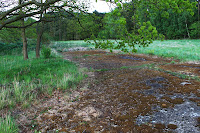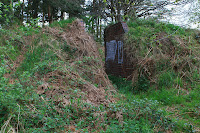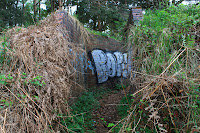Unlike my last blog about RAF Woodhall Spa, this time the difference was drastic, yes the trees were similar, the roots slowly breaking up the concrete, but RAF Skellingthorpe is now very much buried underneath tarmac and houses and the silence that impresses upon you in the Woods at RAF Woodhall Spa is replaced by the constant traffic noise here.
Our first destination were the Bomb stores to the North of where the main airfield site was.
The A46 Lincoln bypass was built in 1986, now splits the site in two, with both areas now dense woodland.
Armed with a copy of the airfield site plans, we set off to see how much was left.
I'll admit I didn't have high expectations from reading other peoples accounts of what remains there. Which was probably the right mindset to have, as it meant anything we did find was a bonus.
The concrete roads are very much visible, leading the way to the blast walls that surround the bomb store.
Inside the mounds of earth, breaking through the brambles and ferns are the ramps that would have been used to move the bombs themselves. The steel rings, now rusted, still protruding from the bricks.
I can't help think what those brave men and women who served here would have thought about it.
After this we made our way around to the south of the airfield. Here there is now a lovely little nature reserve, as well as a reminder of the history of the site.
There is also a bigger reminder, tucked away near to a open grass area lies a circular concrete feature.
To the South East lies the main runway, to the North West, the perimeter track and linking the two this circle of concrete, on which the runway caravan would have sat.
Further north where the nature reserve meets the housing estate is one of the more well known features still standing. A bunker.
A short walk through the houses to the Community centre and we were at the stunning memorial to 50 and 61 Squadrons.
Behind it is a timeline written on a section of perimeter track, giving the history of the site and sadly the losses that took place.
There are 208 poppies painted onto the tarmac to represent the aircraft lost. With over 1980 Air and Ground crews lost from No.50 Squadron and No.61 Squadron combined.
After a moment of reflection and remembrance, we moved on to our next and final destination of the afternoon. Back to the A46, this time on the North bound side of the road. It was raining quite hard when we arrived and I wasn't sure if we would be able to go very far, but it soon stopped and once again we found the concrete roads that 70 years ago would have been busy with men and women preparing the loads for that nights ops.
There is still a lot of evidence of the massive blast walls, less so the buildings that they would have surrounded, almost the opposite of RAF Woodhall where the buildings are pretty much as they were left in 1945 but many of the earth walls have been levelled in order to plant trees.
Incendiary and Pyro stores at RAF Skellingthorpe.
Here you can see the massive blast walls.
Here you can see the massive blast walls.
Sadly the buildings inside are now mostly ruins but to get an idea of what they would have looked like we have to take a brief de tour to RAF Woodhall Spa.
The next three photos are all from Woodhall.
A comparison of the same building types at Skellingthorpe and Woodhall.


Above are the bomb ramps and the photo to the left the roads that would have carried the trucks laden with munitions.
 It had started to spit with rain again as we made our way back towards the noise of the busy A46.
It had started to spit with rain again as we made our way back towards the noise of the busy A46.
I had been following my plans in order to try and locate certain features and one that I was interested to find was listed as a 'Latrine'. It didn't take much to find the solid concrete foundations of the small rectangular building hidden under moss and dead leaves.
I'm not sure why this concrete corner made me so excited, but I count this as my favourite find of the day.
Last but by no means least of our walk around these unassuming woods were these even bigger blast walls.



 Listed as building 12 on the plans, it is a component store.
Listed as building 12 on the plans, it is a component store.
With the exception of the small bit of peri track behind the community centre and a tiny bit of runway near to one of the schools which I didn't visit, there is very little to indicate what was once below the streets and houses.
Of course there are other more obvious signs, the memorial stands on the main road through the estate, and a second memorial can be found in the village of Skellingthorpe next to a small but informative heritage room.
Another small museum to 50 and 61 squadron is open daily inside the community centre.
There are many road names that are named after airbases not just in Lincolnshire, to which there are many, but the rest of the UK.
The Schools also have ties to the site. The Manser school is named after the brave Flying Officer Leslie Thomas Manser VC, of 50 Squadron who lost his life aged just 20 and one month, on the RAF's first 1000 bomber raid to Cologne, May 30th and 31st 1942.
His AVRO Manchester was hit by anti aircraft fire because when heavily laden with a full bomb load he could only get it to fly at 7000 feet, 11000 feet lower than it should have been. Because of this, a search light found his aircraft. More search lights on the ground followed his aircraft zeroing in the anti aircraft fire on their Manchester.
As bomb aimer Richard Barnes dropped the incendiary bombs on the target, one anti aircraft shell exploded inside the bomb bay ripping off the doors and the flak and shrapnel hitting the Manchester wounded the rear gunner B. Naylor.
The Manchester was badly damaged as Manser tried to shake off the search lights. The crew could have bailed out, but he was determined to return to RAF Skellingthorpe.
Unfortunately the aircraft was so badly damaged that it became too difficult to fly, and he knew it would be difficult to make it back to Skellingthorpe so Manser pointed the stricken aircraft in the direction of what would be the nearest allied airfield, RAF Manston in Kent. A fire had started in the central fuselage, the wings were covered with holes and the port engine was over heating which lead to a fire that was eventually brought under control with the internal extinguisher, although it meant the Manchester was now flying on just one engine.
Co Pilot Sergeant L. Baveystock tackled the flames as Manser struggled to get the aircraft to 2000 feet. Flying on one engine the crippled Manchester made it as far as Holland, when the port engine exploded.
His Manchester was loosing height rapidly when Manser gave the order for his crew to parachute to safety whilst he stayed behind the controls, keeping the aircraft steady long enough for the last man, Baveystock, to bail out. Baveystock had returned to hand Manser a parachute but he replied to Baveystock "For God's sake, get out".
Baveystock followed orders and left the aircraft, it turned out to be a very short fall, not even long enough to deploy his parachute fully, into a Dutch dyke, where he watched the aircraft hit the ground and explode.
Leslie Manser's posthumous Victoria Cross was awarded to his widow in October 1943 at Buckingham palace "In recognition of most conspicuous bravery". He would have known how low his Manchester was flying when he gave the order to his crew to bail out, he would also have known that he would have had no chance of bailing out himself.
Thanks to his bravery 5 out of the 6 who bailed out were picked up by the resistance and were back in Britain by October. Only the Navigator, who twisted his ankle, was picked up by the Germans.
I always think of all those brave men who flew from RAF Skellingthorpe when ever I pass through the Birchwood estate which was built on the derelict site in 1970's. I hope that the people who live there also know of the history beneath their feet and spare even the briefest of thoughts to those who did not return.
Bibliography
Brammer, Derek, RAF Skellingthorpe. Lancaster Station at War 1941 - 1945. 2010, Tucann Books.
Otter. Patrick, Lincolnshire Airfields in the Second World War, 1996, Countryside Books.
Matthews, Rupert, Heroes of Bomber Command. Lincolnshire, 2005, Countryside Books.
All photos are taken by myself.
| RAF Skellingthorpe |
A comparison of the same building types at Skellingthorpe and Woodhall.
| RAF Woodhall |
The sun was trying to break through the rain clouds as we left the woods to look for the other bomb stores to the north of the site. The concrete roads are visible on a satellite map of the area.
Above are the bomb ramps and the photo to the left the roads that would have carried the trucks laden with munitions.
I had been following my plans in order to try and locate certain features and one that I was interested to find was listed as a 'Latrine'. It didn't take much to find the solid concrete foundations of the small rectangular building hidden under moss and dead leaves.
I'm not sure why this concrete corner made me so excited, but I count this as my favourite find of the day.
Last but by no means least of our walk around these unassuming woods were these even bigger blast walls.
With the exception of the small bit of peri track behind the community centre and a tiny bit of runway near to one of the schools which I didn't visit, there is very little to indicate what was once below the streets and houses.
Of course there are other more obvious signs, the memorial stands on the main road through the estate, and a second memorial can be found in the village of Skellingthorpe next to a small but informative heritage room.
Another small museum to 50 and 61 squadron is open daily inside the community centre.
There are many road names that are named after airbases not just in Lincolnshire, to which there are many, but the rest of the UK.
The Schools also have ties to the site. The Manser school is named after the brave Flying Officer Leslie Thomas Manser VC, of 50 Squadron who lost his life aged just 20 and one month, on the RAF's first 1000 bomber raid to Cologne, May 30th and 31st 1942.
His AVRO Manchester was hit by anti aircraft fire because when heavily laden with a full bomb load he could only get it to fly at 7000 feet, 11000 feet lower than it should have been. Because of this, a search light found his aircraft. More search lights on the ground followed his aircraft zeroing in the anti aircraft fire on their Manchester.
As bomb aimer Richard Barnes dropped the incendiary bombs on the target, one anti aircraft shell exploded inside the bomb bay ripping off the doors and the flak and shrapnel hitting the Manchester wounded the rear gunner B. Naylor.
The Manchester was badly damaged as Manser tried to shake off the search lights. The crew could have bailed out, but he was determined to return to RAF Skellingthorpe.
Unfortunately the aircraft was so badly damaged that it became too difficult to fly, and he knew it would be difficult to make it back to Skellingthorpe so Manser pointed the stricken aircraft in the direction of what would be the nearest allied airfield, RAF Manston in Kent. A fire had started in the central fuselage, the wings were covered with holes and the port engine was over heating which lead to a fire that was eventually brought under control with the internal extinguisher, although it meant the Manchester was now flying on just one engine.
Co Pilot Sergeant L. Baveystock tackled the flames as Manser struggled to get the aircraft to 2000 feet. Flying on one engine the crippled Manchester made it as far as Holland, when the port engine exploded.
His Manchester was loosing height rapidly when Manser gave the order for his crew to parachute to safety whilst he stayed behind the controls, keeping the aircraft steady long enough for the last man, Baveystock, to bail out. Baveystock had returned to hand Manser a parachute but he replied to Baveystock "For God's sake, get out".
Baveystock followed orders and left the aircraft, it turned out to be a very short fall, not even long enough to deploy his parachute fully, into a Dutch dyke, where he watched the aircraft hit the ground and explode.
Leslie Manser's posthumous Victoria Cross was awarded to his widow in October 1943 at Buckingham palace "In recognition of most conspicuous bravery". He would have known how low his Manchester was flying when he gave the order to his crew to bail out, he would also have known that he would have had no chance of bailing out himself.
Thanks to his bravery 5 out of the 6 who bailed out were picked up by the resistance and were back in Britain by October. Only the Navigator, who twisted his ankle, was picked up by the Germans.
I always think of all those brave men who flew from RAF Skellingthorpe when ever I pass through the Birchwood estate which was built on the derelict site in 1970's. I hope that the people who live there also know of the history beneath their feet and spare even the briefest of thoughts to those who did not return.
Bibliography
Brammer, Derek, RAF Skellingthorpe. Lancaster Station at War 1941 - 1945. 2010, Tucann Books.
Otter. Patrick, Lincolnshire Airfields in the Second World War, 1996, Countryside Books.
Matthews, Rupert, Heroes of Bomber Command. Lincolnshire, 2005, Countryside Books.
All photos are taken by myself.
I love your write up of RAF Skellingthorpe, ive been researching it myself. Where did you get the plans from please? they would be handy to have a copy.
ReplyDeleteMany thanks
Jay
I too love this account. My father was stationed at 'skelly' with 50 squadron and flew 36 operations in VN-U Lancaster as bomb aimer/navigator. There is a photo of his plane in the heratige centre.
ReplyDeleteI would love to have any info pictures from the airfield as it's so emotional seeing where dad was for 3 years.
I grew up in a house built on the main runway, and played in all of the buildings and ruins as a boy. I didn't know half of these facts and stories, thanks for an interesting read.
ReplyDeleteMy Wife's grandfather was stationed at Skellingthorpe. His Lancaster was shot down in September 1944. He and another crewman survived and he was taken in by the Dutch resistance and eventually returned home. You can read a full account of his remarkable story here: http://www.aircrewremembered.com/stone-donald-edward-ross.html
ReplyDelete